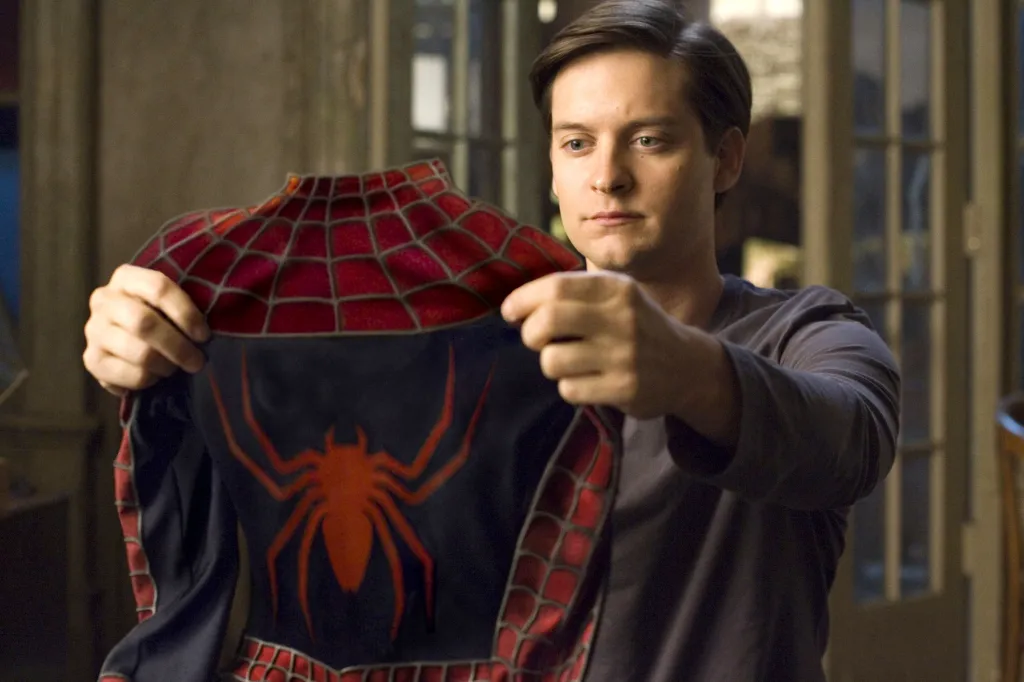Spider-Man 3 (2007)

Spider-Man 3 (2007) – A Tumultuous Journey of Power and Redemption
Introduction
Released in 2007 and directed by Sam Raimi, Spider-Man 3 is the final installment in the original Spider-Man trilogy starring Tobey Maguire. Following the massive success of its predecessors, Spider-Man 3 had high expectations to meet. While it delivered stunning action sequences and emotional depth, the film also faced criticism for its overcrowded narrative and tonal inconsistencies.
Despite these critiques, the film remains a significant entry in the superhero genre, tackling themes of power, vengeance, and redemption. Let’s take a deep dive into what made Spider-Man 3 a polarizing yet unforgettable cinematic experience.
Plot Summary
At the start of the film, Peter Parker (Tobey Maguire) is finally enjoying stability in both his personal and superhero life. He plans to propose to Mary Jane Watson (Kirsten Dunst), and the city adores Spider-Man. However, things quickly spiral out of control when new threats emerge.
Harry Osborn (James Franco), still seeking revenge for his father’s death, assumes the mantle of the New Goblin and attacks Peter. Meanwhile, Flint Marko (Thomas Haden Church), a fugitive struggling to support his sick daughter, falls into a scientific experiment that transforms him into Sandman. To Peter’s horror, he discovers that Marko was actually the man responsible for Uncle Ben’s death.
As Peter battles these external threats, he also wrestles with an internal one. A mysterious alien symbiote bonds with him, enhancing his powers but also bringing out his darkest impulses. This transformation makes him more aggressive, arrogant, and emotionally distant from Mary Jane.
Things escalate when rival photographer Eddie Brock (Topher Grace) is exposed as a fraud and humiliated by Peter. Brock’s hatred leads him to merge with the symbiote, becoming the monstrous Venom. With his relationships in shambles and his enemies growing stronger, Peter must confront his darker self, seek redemption, and reclaim his heroic identity before it’s too late.
Themes and Analysis
The Corrupting Influence of Power
The symbiote storyline serves as a metaphor for how power can corrupt. While the black suit grants Peter enhanced abilities, it also feeds his arrogance and aggression, making him unrecognizable to those around him. The film showcases the struggle between heroism and the temptation of unchecked power.
Forgiveness and Redemption
One of the most compelling aspects of Spider-Man 3 is its focus on forgiveness. Peter’s journey isn’t just about defeating villains but about letting go of anger and embracing compassion. His final confrontation with Sandman is not a violent one but an emotional moment of understanding and closure.
The Complexity of Villains
Unlike typical one-dimensional antagonists, Spider-Man 3 presents its villains with depth and personal struggles. Sandman is not purely evil—he is a desperate man trying to help his daughter. Harry’s arc comes full circle as he transitions from enemy to ally. Even Eddie Brock’s descent into villainy stems from his deep insecurity and need for validation.
Performances and Characters
Tobey Maguire as Peter Parker/Spider-Man
Maguire delivers a strong performance, balancing Peter’s emotional struggles with his descent into arrogance under the symbiote’s influence. His portrayal of a corrupted, darker Spider-Man—infamously showcased through his awkward “emo” dance scene—became both meme-worthy and an intriguing character shift.
Kirsten Dunst as Mary Jane Watson
Dunst brings emotional weight to Mary Jane, portraying her struggles with career setbacks and relationship issues with Peter. However, her character arc feels somewhat repetitive compared to the previous films.
James Franco as Harry Osborn/New Goblin
Franco’s portrayal of Harry’s transformation from a vengeful adversary to a redeemed hero is one of the film’s strongest elements. His tragic fate adds emotional depth to the narrative.
Thomas Haden Church as Sandman
Church delivers a nuanced performance, making Flint Marko one of the most sympathetic villains in the Spider-Man franchise. His tragic backstory and moral conflict elevate him beyond a typical antagonist.
Topher Grace as Eddie Brock/Venom
Grace’s Eddie Brock is an interesting but divisive take on the character. While he effectively portrays Brock’s jealousy and bitterness, some fans felt he lacked the imposing presence traditionally associated with Venom.
Visual Effects and Action Sequences
Spider-Man 3 features some of the most visually impressive action sequences in the trilogy. The aerial battle between Peter and Harry, Sandman’s transformation, and the climactic battle against Venom showcase groundbreaking CGI for its time. However, the inclusion of multiple villains led to a somewhat cluttered storyline, making some moments feel rushed.
Reception and Legacy
Upon its release, Spider-Man 3 received mixed reviews. While praised for its action sequences, emotional depth, and performances, the film was criticized for its convoluted plot and the forced inclusion of Venom at the studio’s insistence. Despite the criticism, it was a massive box office success, grossing nearly $900 million worldwide.
Over the years, Spider-Man 3 has gained a cult following, with fans re-evaluating its themes and character arcs. The film’s portrayal of a flawed hero and its exploration of redemption continue to resonate with audiences, making it a significant entry in the superhero genre.
Conclusion
While not without its flaws, Spider-Man 3 remains a bold and ambitious film that explores the complexities of power, vengeance, and forgiveness. Its emotional moments, impressive visuals, and character-driven conflicts ensure its lasting impact on the Spider-Man legacy.
Whether viewed as an overstuffed blockbuster or an underrated exploration of heroism, Spider-Man 3 is a film that continues to spark debate and discussion among fans of the web-slinger.










